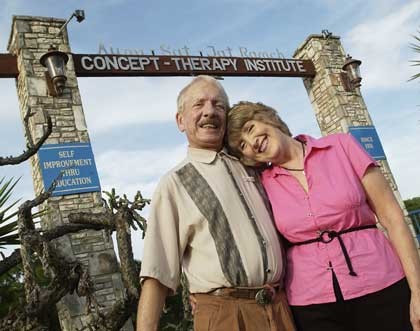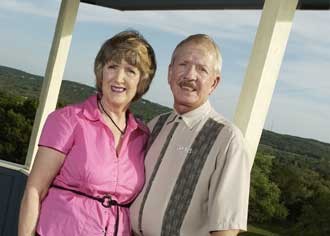Seventy-five years after its creation, Concept Therapy remains a little-understood road map to higher consciousness
When Mary Smith met Graydon Smales in suburban Detroit in the mid-1960s, it was virtually love at first sight. Smith worked as a county switchboard operator, Smales attended Wayne State University, and the two met through a mutual friend who worked with Smith and went to college with Smales.
The matchmaker must have possessed keen instincts, because one week after their first date, Smales proposed to Smith, and a few weeks later they were married. Smith certainly was in no hurry to tie the knot. She’d already received 10 marriage proposals, and had twice been engaged, only to reconsider and return the rings to her suitors. And she’d observed, at close range, the pitfalls of matrimony, because her mother had been married four times.
| Graydon and Mary Love have lived at San Antonio’s Concept Therapy Institute for 39 years. |
She knew, however, that there was something special about Smales, a self-described “flower child,” the moment he began to gush about a self-realization program he’d studied called Concept Therapy. On their wedding night, Smith and Smales attended a Concept Therapy class together. Forty years later, it remains a binding force in their lives: They share a home at the San Antonio-based Concept Therapy Institute, a 300-acre ranch nestled on a lonesome stretch of Boerne Stage Road; they jointly teach courses, and will host an international CT convention this summer; and they’ve passed the principles of Concept Therapy on to their four children, even including their grandchildren in a recent class demonstration about the cellular interaction of protons and electrons.
Partly in tribute to the positivity embraced by Concept Therapy, and partly in reaction to Smales’s lifelong distaste for his last name (which earned playground taunts of “Graydon smells”), the couple changed their last name to Love shortly after their marriage, and bill themselves in the Concept Therapy community as the “Love Team.”
“When Graydon was telling me about some of the things in Concept Therapy, I knew that was something I wanted to investigate,” Mary says. “In that first class, I came to some realizations. For one thing, I didn’t have a soul, I am a soul. And I didn’t have to wait to get to heaven, I’m living in a spiritual world right now.”
Concept Therapy is organized around the notion of integration, the idea that all facets of our being (mind, body, and soul) are constantly connected, and constantly affect each other. So it’s fitting that CT’s chief attribute is the way it integrates all manner of spiritual, psychological, and medical thought into one package that works in harmony with — and never to the exclusion of — other belief systems.
Concept Therapy was created in 1931 by Thurman Fleet, a Blacksburg, Virginia native who’d suffered severe combat wounds in World War I and came home to be told by doctors that he had a year to live. Graydon, who says he grew up 50 miles from Fleet’s hometown, describes Concept Therapy’s founder as a “little hillbilly” with a sixth-grade education. But he says Fleet tapped into the power of suggestion to achieve “something higher than normal consciousness.”
It all began when Fleet, his body riddled with shrapnel and his lungs poisoned by mustard gas, moved to Corpus Christi, bought himself a case of beer, and decided to sit on his porch and drink away his remaining days. One day, while walking the streets of Corpus Christi, he spotted a chiropractic clinic and stopped by. According to legend, the chiropractor assured Fleet that he wasn’t going to die and manipulated Fleet’s spine until small pieces of shrapnel exited his body and his lungs started to improve.
Impressed by what he regarded as a miraculous cure, Fleet began studying at the Texas Chiropractic College, and after receiving his degree, set up a practice in San Antonio. Fleet’s downtown practice quickly developed such powerful word-of-mouth that local police officers had to stand in front of his clinic and direct the long queue of traffic headed his way.
Within a few months, however, Fleet observed that some patients with a particular ailment made full recoveries while others with the same condition failed to see any improvement. Fleet, stymied by the limitations of chiropracty, determined that physical health could not be achieved without a comprehensive, unified program to heal the mind and spirit.
“He closed that chiropractic clinic — sold it for $40,000, which, in the ’30s, was a big chunk of change,” Graydon says. “He bought books from defunct libraries all over the world.”
Fleet did not make new discoveries as much as he cobbled together far-flung theories (from Eastern religions and Christianity, from psychology and nutritional research) to create a cohesive plan for self-improvement and spiritual fulfillment. Concept Therapy followers often talk about how most people aimlessly stumble through life like they’re wearing blindfolds, and they see Concept Therapy as a road map to help them navigate through their existence.
“It makes things a little clearer,” Mary says. “It teaches a thing called ‘right action,’ which is any act that does not cause harm to any part of life,” Mary says. “So when you’re making a decision, you’re supposed to think about whether it’s going to help others and help you, or is it going to hurt others or hurt you. If there’s any hurt involved for anybody, you don’t do it.”
Fleet laid out his manifesto in Rays of the Dawn, a book that began as a series of pamphlets and was published in 1948. By that point, he was teaching Concept Therapy to medical professionals, and would open up the institute to the general public within a few years. Rays of the Dawn, which music producer Quincy Jones has cited as one of several spiritually themed books that helped him overcome a nervous breakdown in the mid-‘80s, outlined what Fleet called the “natural laws” of the body, mind, and soul. The four laws of the body focused on nourishment, movement, recuperation, and sanitation. According to Fleet, the mind and soul each possess 12 laws, including fear, worry, envy, faith, hope, and sympathy.
| “I don’t see any connection between Scientology and Concept Therapy. Theirs is a big money-making thing and `they’ve` got some real strange ideas.” Mary Love |
“With Concept Therapy, they try to put your foot on the path,” Mary says. “It’s like, ‘You’re here for a very short time, so our purpose here in life is to overcome our lower nature, our carnal nature, and to express more of our God nature.’”
The Concept Therapy Institute immediately strikes you as a pleasantly insular world, disconnected from the daily concerns of life in San Antonio. Approximately 70 Concept Therapy practitioners live on the ranch, and some, like ranch landscaper Butch Delgado, have never lived anywhere else. But its insularity has none of the paranoia or suffocating rigidity we associate with religious cults. Graydon talks enthusiastically about his Spurs playoff tickets, and he and Mary openly discuss their years as public-school educators and their concerns for underpaid teachers. In a way, life at the institute most resembles a college-dorm or military base experience: a self-contained environment where you’re surrounded by people who share your interests.
Delgado’s father and mother handled maintenance work at the institute, a job they eventually handed down to him. Along the way, he learned the tenets of Concept Therapy and became a dedicated follower.
“Dr. Fleet used to give tryout talks on the staff,” Delgado recalls. “I used to work outside and he let me come in to listen to it. I must have been 18 or 19. I was a good Catholic and he helped me understand the religions, not just the one religion I knew. It brings it all together real good, because it doesn’t go against the religions.”
The Fleet family owns the ranch, but individuals are able to purchase individual homes on the property. In the ’60s, according to Mary, some people purchased inexpensive homes on the ranch and dumped family members who had personality disorders. The property also became rife with unemployed slackers who spent much of their time smoking pot. This wasn’t the image that the Concept Therapy Institute wanted to project, so the institute’s board instituted a rule that a person selling a home at the ranch must sell to another follower of Concept Therapy. The purchaser must reach Phase Four, a level known as that of a “Path Seeker,” to apply to the board for residence.
| The Love Team will host the institute’s 75th anniversary international convention in July. |
CTI is a state-chartered nonprofit that professes to teach 3,300 students a year, in various parts of the world. In its 2004 federal income tax return, the institute reported net assets of more than $4 million, and an annual operating deficit of more than $500,000.
Opal Downs, 81, has lived at the institute for 53 years, and is one of the most persuasive advocates for the power of Concept Therapy. She came from Houston after being diagnosed with leukemia and told by medical doctors that nothing could be done to save her. She had three brothers who were chiropractors, and they told her about Fleet. Weighing only 98 pounds, and with her condition deteriorating rapidly, she figured she had nothing to lose.
“At that time, nobody ever got healed of leukemia,” says the impossibly ebullient Downs, who warmly hugs visitors to the center and laughs with great regularity. “They had a clinic here, and I went in. I guess a lot of people thought I was a good-looking gal and the doctor they had in here tried to put the make on me and I thought, ‘Oh, my God, what am I going to do?’
“I was going out the door of the clinic when I met Thurman Fleet. And I felt something I’d never felt before in my life. When I went back home, my family thought something really strange had happened, there was so much difference in me. They were shocked.”
It’s a sentiment commonly voiced by members of the Institute. Graydon, in a folksy introduction to the institute’s recent weekend seminar, talked about being a sickly child dubbed “Poor Little Graydon” by his sisters. After Concept Therapy classes convinced him that “I am responsible for my own happiness and my own health,” his newly acquired sense of vigor alarmed his family. His mother called CT a “cult,” and a “moonie group,” according to Graydon, and she wondered if his uncharacteristic cheerfulness meant he was on drugs. Reluctantly, however, she ageed to attend a class, and came away convinced that nothing in Concept Therapy contradicted the belief system of her Presbyterian faith.
Fleet, who passed away in 1983, was always careful not to market Concept Therapy too aggressively, because he didn’t want it to be confused with a religion. And many of its adherents continue to follow the religious denominations of their youth. At a time when the debate between evolutionists and creationists is intensifying and both sides feel culturally beleaguered, Concept Therapy readily accepts both premises. Concept Therapy teachers might not call their theory “intelligent design,” but they do see the handiwork of a supreme being, even as they support the scientific, Darwinian model of how life evolved.
Graydon likes to tell his students that Concept Therapy “isn’t for everyone, it’s for seekers, people looking for answers to the riddles of life.” Mary describes herself as someone who’s been on such a quest since her childhood.
“I remember asking questions about the Virgin Birth and the Resurrection and they would always say it was a Glorious Mystery,” she says. “You weren’t supposed to question it. But that didn’t satisfy me.”
Skinny and mustachioed, with white hair, and a soft, mellifluous voice, Graydon is affable and warm, the epitome of an antebellum Southern gentleman. In contrast, Mary conveys an intense elegance, a more cerebral, introspective quality. Their teaching approaches effectively balance each other out, and you sense that their personality differences have kept them together for 40 years.
Graydon worked as a public-school teacher and principal for 30 years, and Mary taught kindergarten for 14 years. Between their work commitments and Mary’s time looking after their grandchildren, they found that they didn’t have enough time to continue teaching Concept Therapy. For 20 years, they stopped teaching CT courses, until early this year, when Graydon told Mary he missed it.
All four of Graydon and Mary’s children were born and raised at the institute, in a small ranchhouse with one bathroom. They all follow the teachings of Concept Therapy. Graydon says, with obvious pride: “They really all are prodigies. Our daughter is the youngest senior vice-president they’ve ever had at USAA.”
Because Concept Therapy, like Scientology, is an intricate program designed to heighten health and spiritual awareness, and because it is sometimes mistaken for a religion, it is inevitable that comparisons would be made between the two discliplines.
“I don’t see any connection between Scientology and Concept Therapy,” Mary says. “Theirs is a big money-making thing and `they’ve` got some real strange ideas. I think a lot of people who are in that just have to be wealthy.”
She’s quick to note that Concept Therapy always offers a money-back guarantee to students if they leave a class feeling dissatisfied with what they’ve learned. It’s an offer she once accepted.
“I took a course back in the ‘60s, taught by a team from Milwaukee,” she says. “I felt like the teacher was hollering at me, so I asked for my money back at the end of the class and he gave it back to me. They’re going to be honored at the international convention we’re having in July. And I’m going to apologize.”




















